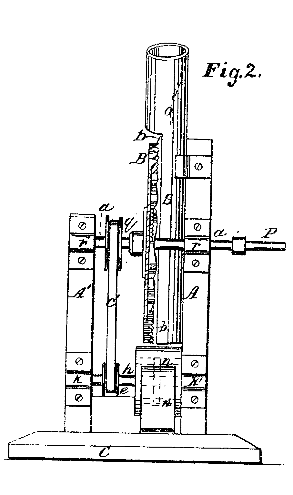In honor of Black History Month, IPWatchdog will be featuring profiles of black women inventors—some of whom are little-known and many of whom never profited from their inventions—throughout the month of February.
Martha Jones of Amelia County, Virginia, is believed by many to be the first black woman to receive a United States patent. Her application for an “Improvement to the Corn Husker, Sheller” was granted U.S. patent No. 77,494 in 1868. Jones claimed her invention could husk, shell, cut up, and separate husks from corn in one operation, representing a significant step forward in the automation of agricultural processes.
Early Struggles
 African American women have contributed greatly to America’s culture of innovation, and patents are one way to glimpse into the stories of black female inventors. However, since patents do not record details about inventors, such as race and gender—something we’re only beginning to tackle today—it is difficult to ascertain a significant amount of information about these early inventors. Jones’ patent issued prior to 1793, when the Patent Act was amended to include a “Patent Oath,” which required patent applicants to swear to be the “original” inventor of the claimed invention and to assert their U.S. citizenship, which African Americans could not legally do under the Dred Scott decision. Thus, it was possible that there were earlier African American women who were the rightful inventors of prior patents filed in the name of someone else. In addition, the economic and educational limitations that many African Americans faced undoubtedly made it difficult to pursue any benefits provided by the U.S. patent law.
African American women have contributed greatly to America’s culture of innovation, and patents are one way to glimpse into the stories of black female inventors. However, since patents do not record details about inventors, such as race and gender—something we’re only beginning to tackle today—it is difficult to ascertain a significant amount of information about these early inventors. Jones’ patent issued prior to 1793, when the Patent Act was amended to include a “Patent Oath,” which required patent applicants to swear to be the “original” inventor of the claimed invention and to assert their U.S. citizenship, which African Americans could not legally do under the Dred Scott decision. Thus, it was possible that there were earlier African American women who were the rightful inventors of prior patents filed in the name of someone else. In addition, the economic and educational limitations that many African Americans faced undoubtedly made it difficult to pursue any benefits provided by the U.S. patent law.
Jones also faced challenges as a female inventor. Demonstrating the racial gap, Jones received her patent in 1868, 59 years after the first white woman to receive a patent in 1809, Mary Kies. Similarly, Jones’ patent issued 47 years after Thomas Jennings became the first black man to receive a U.S. Patent in 1821.
The Corn Husker, Sheller
 Jones’ invention related to a machine for “husking, shelling, cutting up the husks, and separating them from the grain.” Recognizing the economic benefits of reusing the waste, she noted corn husks may be used a source of nutrients and can serve as a substitute for hay or straw and used to feed horses and other farm animals. She also explained that the cut husks may be used as a substitute for mattresses or similar purposes.
Jones’ invention related to a machine for “husking, shelling, cutting up the husks, and separating them from the grain.” Recognizing the economic benefits of reusing the waste, she noted corn husks may be used a source of nutrients and can serve as a substitute for hay or straw and used to feed horses and other farm animals. She also explained that the cut husks may be used as a substitute for mattresses or similar purposes.
Jones’ invention operated by introducing ears of corn into an upper end of the machine and pressing them against the face of a wheel that has a plurality of projections for cutting the ears of corn. The device also included spirally arranged knives for cutting up the husks. Thus, the projections on the wheel shelled the ears of corn and the corn fell onto an inclined board while a fan-wheel drove the lighter husks away from the corn. Jones also included an alternate embodiment wherein the wheel did not include projections so the ears of corn could be husked, and husks could be cut up without shelling the corn.
From the Patent:
It is well known that much nutriment is contained in corn-husks, and when properly cut up and mixed with water and meal, or mill-feed, the husks – thus prepared are deemed an excellent substitute for hay or straw, which are ordinarily cut up to mix with water and mill-feed for horses or other farm-animals. The cut husks are also employed alone, at times, as a substitute for hay or straw for farm-stock, and it is found more economical to feed them when cut up, as great waste, caused by their being pulled from the manger or rack, and trodden under the feet of the animals, arises from using them without being cut up. The cut husks may likewise be used for mattresses and other like purposes….
Having thus fully described my invention, what I claim as new, and desire to secure by Letters Patent, is
-
- A machine, so constructed as to be capable of husking the ears of maize or Indian corn, and at the same operation cutting up the husks, for the purposes set forth.

![[IPWatchdog Logo]](https://ipwatchdog.com/wp-content/themes/IPWatchdog%20-%202023/assets/images/temp/logo-small@2x.png)

![[[Advertisement]]](https://ipwatchdog.com/wp-content/uploads/2024/04/Patent-Litigation-2024-banner-938x313-1.jpeg)
![[Advertisement]](https://ipwatchdog.com/wp-content/uploads/2024/04/UnitedLex-May-2-2024-sidebar-700x500-1.jpg)
![[Advertisement]](https://ipwatchdog.com/wp-content/uploads/2024/04/Artificial-Intelligence-2024-REPLAY-sidebar-700x500-corrected.jpg)
![[Advertisement]](https://ipwatchdog.com/wp-content/uploads/2024/04/Patent-Litigation-Masters-2024-sidebar-700x500-1.jpg)

![[Advertisement]](https://ipwatchdog.com/wp-content/uploads/2021/12/WEBINAR-336-x-280-px.png)
![[Advertisement]](https://ipwatchdog.com/wp-content/uploads/2021/12/2021-Patent-Practice-on-Demand-recorded-Feb-2021-336-x-280.jpg)
![[Advertisement]](https://ipwatchdog.com/wp-content/uploads/2021/12/Ad-4-The-Invent-Patent-System™.png)






Join the Discussion
One comment so far.
Natalie Feldman
February 10, 2021 09:12 amRebecca Tapscott, thank you for this informative and well written article. This and the other posts you have recently written about women inventors and especially women inventors of color are important to our culture and critical to know. Thanks!